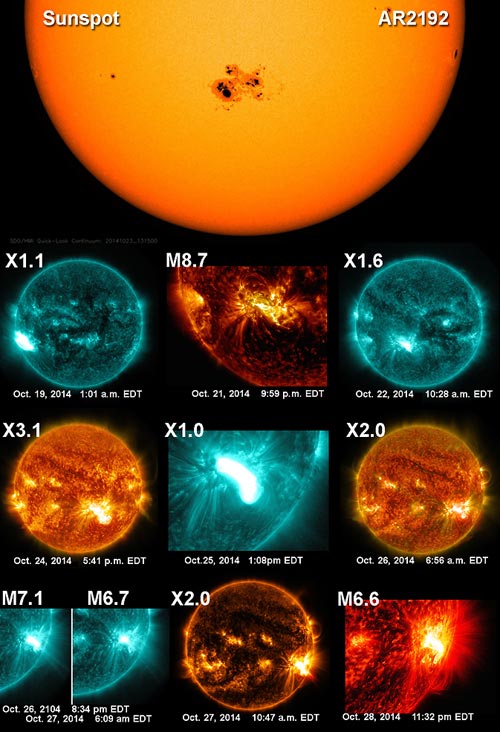Tracking a Gigantic Sunspot Across the Sun

Super sunspot AR2192 produced 10 significant solar flare while traversing the Earth-side of the sun; six X-class and four above M5-class. Image Credit: NASA/SDO
“Despite all the flares, this region did not produce any significant coronal mass ejections,” said Alex Young a solar scientist at NASA's Goddard Space Flight Center in Greenbelt, Maryland. Coronal mass ejections, or CMEs, are giant clouds of solar particles that can affect technology when they reach near-Earth space.
“You certainly can have flares without CMEs and vice versa, but most big flares do have CMEs. So we're learning that a big active region doesn't always equal the biggest events.”
Such active regions are measured in millionths of a solar hemisphere, where 1 micro-hemisphere, or MH, is about 600,000 square miles. This region topped out at 2,750 MH, making it the 33rd largest region out of approximately 32,000 active regions that have been tracked and measured since 1874. It is the largest sunspot seen since AR 6368, which measured 3,080 MH on Nov. 18, 1990.
The largest five active regions ever observed were between 4,000 and more than 6,000 MH and they all appeared between 1946 and 1951.
On the other hand, the region that produced one of the biggest solar flares of all time on Sep. 1, 1859 – in what's known as the Carrington event – wasn't even one of the top 50 at only 2,300 MH.
During its trip across the front of the sun, AR 12192 produced six X-class flares, which are the largest flares, and four strong M-class flares. M-class flares are one tenth as strong as X-class flares. The number provides more information about its strength. An M2 is twice as intense as an M1, an M3 is three times as intense, etc.
“Having so many similar flares from the same active region will be a nice case study for people who work on predicting solar flares,” said Dean Pesnell, project scientist for NASA's Solar Dynamics Observatory at Goddard. “This is important for one day improving the nation's ability to forecast space weather and protect technology and astronauts in space.”
The dates and peak times in EDT of the large solar flares from AR 12192 are as follows:
Oct. 19, 1:01 am: X1.1
Oct. 21, 9:59 pm: M8.7
Oct. 22, 10:28 am: X1.6
Oct. 24, 5:41 pm: X3.1
Oct. 25, 1:08 pm: X1.0
Oct. 26, 6:56 am: X2.0
Oct. 26, 8:34 pm: M7.1
Oct. 27, 6:09 am: M6.7
Oct. 27, 10:47 am: X2.0
Oct. 28, 11:32 pm: M6.6
AR 12192 rotated onto the far side of the sun on Oct. 30, 2014, however as it evolves, we may see a new version of it rotating back into view in two weeks.
Related Links:
For more on this gigantic sunspot and its flares:
> http://www.nasa.gov/content/goddard/sdo-observes-largest-sunspot-of-the-solar-cycle/
> http://www.nasa.gov/content/goddard/sdo-observes-more-flares-erupting-from-giant-sunspot/
> http://www.nasa.gov/content/goddard/one-giant-sunspot-6-substantial-flares/
> http://www.nasa.gov/content/goddard/oct-22-2014-third-substantial-solar-flare-in-2-days/
> http://www.nasa.gov/content/goddard/sdo-observes-an-x-class-solar-flare/
> Sunspot AR2192 Flare Family Portrait
> Sunspot AR2192 Flare Family Portrait – Unlabeled
> Download high resolution media from Oct. 24, 2014
> Download high resolution media from Oct. 22, 2014
> What does it take to be X-class?
Karen C. Fox
NASA's Goddard Space Flight Center, Greenbelt, Md.
Media Contact
All latest news from the category: Physics and Astronomy
This area deals with the fundamental laws and building blocks of nature and how they interact, the properties and the behavior of matter, and research into space and time and their structures.
innovations-report provides in-depth reports and articles on subjects such as astrophysics, laser technologies, nuclear, quantum, particle and solid-state physics, nanotechnologies, planetary research and findings (Mars, Venus) and developments related to the Hubble Telescope.
Newest articles

High-energy-density aqueous battery based on halogen multi-electron transfer
Traditional non-aqueous lithium-ion batteries have a high energy density, but their safety is compromised due to the flammable organic electrolytes they utilize. Aqueous batteries use water as the solvent for…

First-ever combined heart pump and pig kidney transplant
…gives new hope to patient with terminal illness. Surgeons at NYU Langone Health performed the first-ever combined mechanical heart pump and gene-edited pig kidney transplant surgery in a 54-year-old woman…

Biophysics: Testing how well biomarkers work
LMU researchers have developed a method to determine how reliably target proteins can be labeled using super-resolution fluorescence microscopy. Modern microscopy techniques make it possible to examine the inner workings…





















